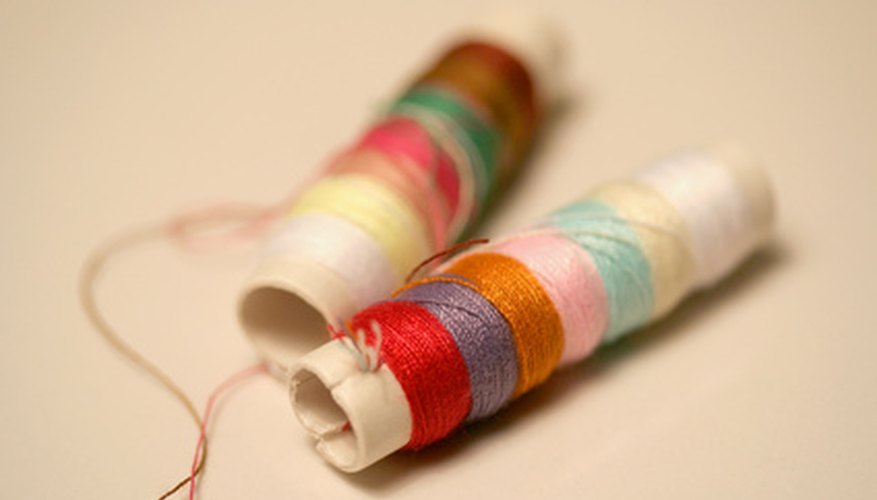Sweden and all of Scandinavia share common culture through their at-times porous borders and their traditional crafts. While Scandinavian-style weaving suggests all-natural, knotted fabrics and handiwork, Sweden in particular serves as the forerunner of bringing linen and damask-style weaving into the nation and northern Europe. Through a flux of styles and techniques--from hand-woven blankets and rugs to the invention of looms for bedding and clothes--Swedish locals own their own style of weaving and its influence on the western world.
Terms & Other Names
Swedish weaving is also known as Huck Embroidery, Huckaback, Popcorn Embroidery (Popcorn Cloth). According to Crochet.org writer Ruthie Marks, the Swedish weaving process is what the French, Spanish, English and Americans know as crochet. In Sweden the name of their weaving is "virkning." Swedish weaving uses an assortment of threads and fabrics, but Sweden is known for incorporating linen into needlework crafts.
- Swedish weaving is also known as Huck Embroidery, Huckaback, Popcorn Embroidery (Popcorn Cloth).
- In Sweden the name of their weaving is "virkning."
According to Webster's Unabridged dictionary, huckaback comes from the term huckster, a name for peddlers and their wares. Huckaback was the name for linen cloth with raised features.
Earliest Swedish Weaving
In the 12th century, Swedish weavers began using natural linens as a weaving background, wherein they threaded patterns into linen as a base material. Linen alone was used as a common cloth for centuries in Sweden before weavers used it as a backdrop cloth. Swedes added natural dyes, and the background linen was also local and natural. A tapestry, rug, blanket or throw from that era worked the land and the weaver's hands into a historic timepiece.
- In the 12th century, Swedish weavers began using natural linens as a weaving background, wherein they threaded patterns into linen as a base material.
A Queen's Support
In 1696, then queen of Sweden, Hedvig Eleonora, ordered a large amount of tablecloths and napkins from weavers in Stockholm. According to Klassbols Weaving Mill in Sweden, this financially ensured Swedish weavers that the Swedish linen damask industry (a fine-weaving type originating in Damascus) would grow significantly due to the queen's support of the project. Three early 18th-century napkins show the queen's crest, name and three crowns handwoven into the fabric.
Early Swedish Weaving Looms

In 1805, Joseph Marie Jacquard of France constructed a weaving machine. Modernly known as the Jacquard loom, the machine ended the tedious and laborious era of hand-weaving blankets, throws, napkins and tablecloths. Unveiled around Europe as a miracle machine, the invention also created possibilities for the damask weaving industry, which incorporated linen and ornamental designs.
According to an article published on Farm Collector, discussing significant inventions and tools, in 1832, a Swedish 28-year-old named Johan Theofron Munktell built Sweden's first weaving loom. He started a workshop in Eskilstuna, Sweden, where he tailored the loom's design to perfection. His hands went onto create the first mowing machine, first steam locomotive and the country's first steam traction engine.
- In 1805, Joseph Marie Jacquard of France constructed a weaving machine.
- According to an article published on Farm Collector, discussing significant inventions and tools, in 1832, a Swedish 28-year-old named Johan Theofron Munktell built Sweden's first weaving loom.
Friends of Handicraft
A few Swedish women weavers founded the Handarbetets Vanner (Friends of Handicraft) in 1874. Sophie Adlersparre, Molly Rohtlieb and Hanna Mathilda Winge combined traditional Swedish hand-weaving and tapestry into popular crafting techniques for urban buyers and traders.
Rya Rugs & Tapestries
According to All Fiber Arts, who look closely at the story of fabrics and tapestries, a Rya tapestry is similar to a finely knotted Persian carpet but has its roots in Scandinavia. In Norway, ryas date back to the early 1400s, where they were used as bed coverings for warmth. In Swedish castles, artisans wove ryas as bedding throughout the 16th century.
Popularity in the U.S.
Sweden's style of needlework art grew popular in the U.S. in the 1930s and '40s. Mary Thomas's "Embroidery Book," first published in London in 1936, taught English schoolgirls and later American schoolgirls how to weave in the Swedish style.
American homemakers decorated the borders of towels with Swedish-style embroidery floss, a late-Depression era favourite. However, the knotted weaving style fell flat at the end of WWII due in part to industrialism and less handicrafts. In the 1960s the weaving technique experienced a slight revival. Modern weaving styles can be seen in Afghan throws, chunky blankets and knotted fabric pillows.
- Sweden's style of needlework art grew popular in the U.S. in the 1930s and '40s.
- However, the knotted weaving style fell flat at the end of WWII due in part to industrialism and less handicrafts.
